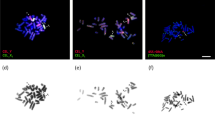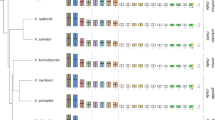Abstract
In many eutherian mammals, X–Y chromosome pairing and recombination is required for meiotic progression and correct sex chromosome disjunction. Arvicoline rodents present a notable exception to this meiotic rule, with multiple species possessing asynaptic sex chromosomes. Most asynaptic vole species belong to the genus Microtus sensu lato. However, many of the species both inside and outside the genus Microtus display normal X–Y synapsis at meiosis. These observations suggest that the synaptic condition was present in the common ancestor of all voles, but gaps in current taxonomic sampling across the arvicoline phylogeny prevent identification of the lineage(s) along which the asynaptic state arose. In this study, we use electron and immunofluorescent microscopy to assess heterogametic sex chromosome pairing in 12 additional arvicoline species. Our sample includes ten species of the tribe Microtini and two species of the tribe Lagurini. This increased breadth of sampling allowed us to identify asynaptic species in each major Microtine lineage. Evidently, the ability of the sex chromosomes to pair and recombine in male meiosis has been independently lost at least three times during the evolution of Microtine rodents. These results suggest a lack of evolutionary constraint on X–Y synapsis in Microtini, hinting at the presence of alternative molecular mechanisms for sex chromosome segregation in this large mammalian tribe.




Similar content being viewed by others
Abbreviations
- BSA:
-
Bovine serum albumin
- Cy3:
-
Orange fluorescing cyanine
- DAPI:
-
4′-6-Diamidino-2-phenylindole
- EM:
-
Electron microscopy
- FITC:
-
Fluorescein isothiocyanate
- FM:
-
Fluorescent microscopy
- MLH1:
-
Homolog of prokaryotic mutL 1 mismatch repair protein
- SC:
-
Synaptonemal complex
- SCP3:
-
Synaptonemal complex protein 3
References
Abramson NI, Lebedev VS, Bannikova AA, Tesakov AS (2009) Radiation events in the subfamily Arvicolinae (Rodentia): evidence from nuclear genes. Dokl Biol Sci 428:458–461
Acosta MJ, Romero-Fernandez I, Sanchez A, Marchal JA (2011) Comparative analysis by chromosome painting of the sex chromosomes in arvicolid rodents. Cytogenet Genome Res 132(1–2):47–54
Anderson LK, Reeves A, Webb LM, Ashley T (1999) Distribution of crossing over on mouse synaptonemal complexes using immunofluorescent localization of MLH1 protein. Genetics 151(4):1569–1579
Ashley T, Fredga K (1994) The curious normality of the synaptic association between the sex chromosomes of two arvicoline rodents: Microtus oeconomus and Clethrionomys glareolus. Hereditas 120(2):105–111
Ashley T, Jaarola M, Fredga K (1989) Absence of synapsis during pachynema of the normal sized sex chromosomes of Microtus arvalis. Hereditas 111(3):295–304
Ashley T, Jaarola M, Fredga K (1990) The behavior during pachynema of a normal and an inverted Y chromosome in Microtus agrestis. Hereditas 111(3):281
Baker SM, Plug AW, Prolla TA et al (1996) Involvement of mouse Mlh1 in DNA mismatch repair and meiotic crossing over. Nat Genet 13(3):336–342
Bannikova A, Lebedev V, Golenishchev F (2009) Taxonomic position of Afghan vole (Subgenus Blanfordimys) by the sequence of the mitochondrial cytb gene. Russ J Genet 45(1):91–97
Bannikova AA, Lebedev VS, Lissovsky AA et al (2010) Molecular phylogeny and evolution of the Asian lineage of vole genus Microtus (Rodentia: Arvicolinae) inferred from mitochondrial cytochrome b sequence. Biol J Linn Soc 99(3):595–613
Basheva EA, Bidau CJ, Borodin PM (2008) General pattern of meiotic recombination in male dogs estimated by MLH1 and RAD51 immunolocalization. Chromosome Res 16(5):709–719
Bogdanov YF, Kolomiets OL, Lyapunova EA et al (1986) Synaptonemal complexes and chromosome chains in the rodent Ellobius talpinus heterozygous for ten Robertsonian translocations. Chromosoma 94(2):94
Borodin PM (1991) Synaptonemal complexes of the common shrew, Sorex araneus L., in spermatocyte spreads. Cytogenet Cell Genet 56(1):61–62
Borodin PM, Sablina OV, Rodionova MI (1995) Pattern of X–Y chromosome pairing in microtine rodents. Hereditas 123(1):17–23
Borodin PM, Rogatcheva MB, Koyasu K et al (1997) Pattern of X–Y chromosome pairing in the Japanese field vole, Microtus montebelli. Genome 40(6):829–833
Borodin PM, Basheva EA, Dashkevich OA et al (2011) XY chromosome synapsis and recombination in 3 vole species of Asian lineage of the genus Microtus (Rodentia: Arvicolinae). Cytogenet Genome Res 132(1–2):129–133
Burgoyne PS, Mahadevaiah SK, Sutcliffe MJ, Palmer SJ (1992) Fertility in mice requires X–Y pairing and a Y-chromosomal “spermiogenesis” gene mapping to the long arm. Cell 71(3):391–398
Carnero A, Jimenez R, Burgos M et al (1991) Achiasmatic sex chromosomes in Pitymys duodecimcostatus: mechanisms of association and segregation. Cytogenet Cell Genet 56(2):78–81
Conroy CJ, Cook JA (2000) Molecular systematics of a holarctic rodent (Microtus: Muridae). J Mamm 81(2):344–359
de la Fuente R, Parra MT, Viera A et al (2007) Meiotic pairing and segregation of achiasmate sex chromosomes in eutherian mammals: the role of SYCP3 protein. PLoS Genet 3(11):e198
Deakin JE, Waters PD, Marshall Graves JA et al (2010) Marsupial sex chromosome behaviour during male meiosis. In: Deakin JE et al (eds) Marsupial genetics and genomics. Springer, Dordrecht, p 187
Froenicke L, Anderson LK, Wienberg J, Ashley T (2002) Male mouse recombination maps for each autosome identified by chromosome painting. Am J Hum Genet 71(6):1353–1368
Graves JA, Wakefield MJ, Toder R (1998) The origin and evolution of the pseudoautosomal regions of human sex chromosomes. Hum Mol Genet 7(13):1991–1996
Gu W, Wang T, Zhu B (1999) Study on the morphology of sex chromosomes pairing of the synaptonemal complexs in Mandarin vole (Microtus mandarinus). Acta Theriol Sin 19:150–154 (in Chinese)
Hassold T, Hunt P (2001) To err (meiotically) is human: the genesis of human aneuploidy. Nat Rev Genet 2(4):280–291
Howell WM, Black DA (1980) Controlled silver-staining of nucleolus organizer regions with a protective colloidal developer: a 1-step method. Experientia 36(8):1014–1015
Iwasa MA, Obara Y, Kitahara E, Kimura Y (1999) Synaptonemal complex analyses in the XY chromosomes of six taxa of Clethrionomys and Eothenomys from Japan. Mammal Study 24:103–113
Jaarola M, Martinkova N, Gunduz I et al (2004) Molecular phylogeny of the speciose vole genus Microtus (Arvicolinae, Rodentia) inferred from mitochondrial DNA sequences. Mol Phylogenet Evol 33(3):647–663
Jimenez R, Carnero A, Burgos M et al (1991) Achiasmatic giant sex chromosomes in the vole Microtus cabrerae (Rodentia, Microtidae). Cytogenet Cell Genet 57(1):56–58
Mangs HA, Morris BJ (2007) The human pseudoautosomal region (PAR): origin, function and future. Curr Genomics 8(2):129–136
Marchal JA, Acosta MJ, Nietzel H et al (2004) X chromosome painting in Microtus: origin and evolution of the giant sex chromosomes. Chromosome Res Int J Mol Supramol Evol Aspects Chromosome Biol 12(8):767–776
Megias-Nogales B, Marchal JA, Acosta MJ et al (2003) Sex chromosomes pairing in two Arvicolidae species: Microtus nivalis and Arvicola sapidus. Hereditas 138(2):114–121
Mekada K, Harada M, Lin LK et al (2001) Pattern of X–Y chromosome pairing in the Taiwan vole, Microtus kikuchii. Genome 44(1):27–31
Mekada K, Koyasu K, Harada M et al (2002) Karyotype and X–Y chromosome pairing in the Sikkim vole (Microtus(Neodon) sikimensis). J Zool 257(3):417–423
Mohandas TK, Speed RM, Passage MB et al (1992) Role of the pseudoautosomal region in sex-chromosome pairing during male meiosis: meiotic studies in a man with a deletion of distal Xp. Am J Hum Genet 51(3):526–533
Moses MJ (1980) New cytogenetic studies on mammalian meiosis. In: Serio M, Martini L (eds) Animal models in human reproduction. Raven, New York, pp 169–190
Musser GG, Carleton MD (2005) Superfamily Muroidea. In: Wilson DE, Reeder DM (eds) Mammal species of the world a taxonomic and geographic reference. Johns Hopkins University Press, Baltimore, pp 894–1531
Pack SD, Borodin PM, Serov OL, Searle JB (1993) The X-autosome translocation in the common shrew (Sorex araneus L.): late replication in female somatic cells and pairing in male meiosis. Chromosoma 102(5):355–360
Page J, Berrios S, Rufas JS et al (2003) The pairing of X and Y chromosomes during meiotic prophase in the marsupial species Thylamys elegans is maintained by a dense plate developed from their axial elements. J Cell Sci 116(Pt 3):551–560
Page J, Viera A, Parra MT et al (2006) Involvement of synaptonemal complex proteins in sex chromosome segregation during marsupial male meiosis. PLoS Genetics 2(8):e136
Peters AH, Plug AW, van Vugt MJ, de Boer P (1997) A drying-down technique for the spreading of mammalian meiocytes from the male and female germline. Chromosome Res 5(1):66–68
Rovatsos MT, Mitsainas GP, Stamatopoulos C, Giagia-Athanasopoulou EB (2008) First reports of XXY aneuploidy in natural populations of Thomas’ pine vole Microtus thomasi (Rodentia: Arvicolidae) from Greece. Mamm Biol 73(5):342–349
Speed RM, Chandley AC (1990) Prophase of meiosis in human spermatocytes analysed by EM microspreading in infertile men and their controls and comparisons with human oocytes. Hum Genet 84(6):547–554
Wilson DE, Reeder DM (2005) Mammal species of the world: a taxonomic and geographic reference, vol 2, 3rd edn. Johns Hopkins University Press, Baltimore, p xxxv, 2142 pp
Wolf KW, Baumgart T, Winking H (1988) Meiotic association and segregation of the achiasmatic giant sex chromosomes in the male field vole (Microtus agrestis). Chromosoma 97:124–133
Acknowledgments
This work was supported by research grants from Russian Foundation for Basic Research (to PMB, EAB, AAT, OAD, FNG, IVK), Siberian and Far Eastern Departments of Russian Academy of Sciences (to PMB and IVK), National Science Foundation Predoctoral Fellowship (to BLD), and Japan Science Society Sasagawa Scientific Research Grant (to KM). We thank Mrs. Marina Rodionova for her help in SC spreading; Drs. Andrei Dobrotvorsky, Victor Panov, Yuichi Narita, Bruce Cushing, Nancy Cushing, and Ms. Roni Yi-Ju Chen for providing of animals; Drs. Sen-ichi Oda, Kazuhiro Koyasu, Masashi Harada, and Vladimir Lebedev for valuable advices; and the Microscopic Center of the Siberian Department of Russian Academy of Sciences for granting access to microscopic equipment.
Author information
Authors and Affiliations
Corresponding author
Additional information
Responsible Editor: Herbert Macgregor.
Rights and permissions
About this article
Cite this article
Borodin, P.M., Basheva, E.A., Torgasheva, A.A. et al. Multiple independent evolutionary losses of XY pairing at meiosis in the grey voles. Chromosome Res 20, 259–268 (2012). https://doi.org/10.1007/s10577-011-9261-0
Received:
Revised:
Accepted:
Published:
Issue Date:
DOI: https://doi.org/10.1007/s10577-011-9261-0




